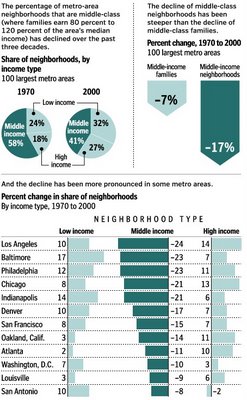Thursday, June 22, 2006
Middle Class splits for the outer suburbs!
 U.S. Losing Its Middle-Class NeighborhoodsFrom 1970 to 2000, Metro Areas Showed Widening Gap Between Rich, Poor Sections
U.S. Losing Its Middle-Class NeighborhoodsFrom 1970 to 2000, Metro Areas Showed Widening Gap Between Rich, Poor SectionsBy Blaine HardenWashington Post Staff WriterThursday, June 22, 2006; A03
INDIANAPOLIS -- Middle-class neighborhoods, long regarded as incubators for the American dream, are losing ground in cities across the country, shrinking at more than twice the rate of the middle class itself.
In their place, poor and rich neighborhoods are both on the rise, as cities and suburbs have become increasingly segregated by income, according to a Brookings Institution study released Thursday. It found that as a share of all urban and suburban neighborhoods, middle-income neighborhoods in the nation's 100 largest metro areas have declined from 58 percent in 1970 to 41 percent in 2000.
Widening income inequality in the United States has been well documented in recent years, but the Brookings analysis of census data uncovered a much more accelerated decline in communities that house the middle class. It far outpaced the decline of seven percentage points between 1970 and 2000 in the proportion of middle-income families living in and around cities.
Middle-income neighborhoods -- where families earn 80 to 120 percent of the local median income -- have plunged by more than 20 percent as a share of all neighborhoods in Baltimore, Chicago, Los Angeles and Philadelphia. They are down 10 percent in the Washington area.
It's happening, too, in this prosperous, mostly white middle-income Midwestern city where unemployment is low and a vibrant downtown has been preserved. As poor and rich neighborhoods proliferate, the share of middle-income neighborhoods in greater Indianapolis has dropped by 21 percent since 1970.
"No city in America has gotten more integrated by income in the last 30 years," said Alan Berube, an urban demographer at Brookings who worked on the report.
"It means that if you are not living in one of the well-off areas, you are not going to have access to the same amenities -- good schools and safe environment -- that you could find 30 years ago," he said.
The decline of middle-income neighborhoods may also be a consequence of increased economic opportunity and residential mobility, especially for upper-income minorities, said Joel Kotkin, an urban historian and senior fellow at the New America Foundation.
"This is about upward mobility and class. Until the 1970s, middle-class blacks and other minorities often had little choice about where they could live," said Kotkin, the author of "The City: A Global History." He added: "They usually had to live close to lower-income people of their own race. Now, if they can afford it, they can move to higher-income neighborhoods. Dollars trump race. Many choose not to live around poor people."
The Brookings study says that much more research is needed to better understand why middle-income neighborhoods are vanishing faster than middle-income families. But it speculates that a sorting-out process is underway in the nation's suburbs and inner cities, with many previously middle-income neighborhoods now tipping rich or poor.
Several urban scholars who had no role in the Brookings study said that its findings are consistent with what they have seen in cities from Los Angeles to Cleveland, as the middle class hollows out and as an economic chasm widens between rich and poor neighborhoods.
"We are increasingly being bifurcated on an economic basis," said Paul Ong, a professor of public affairs at the University of California at Los Angeles. "It has taken a big chunk out of the middle."
In Los Angeles -- the most hollowed-out metropolitan area in the country over the past three decades -- the share of poor neighborhoods is up 10 percent, rich neighborhoods are up 14 percent and middle-income areas are down by 24 percent.
The Brookings study says that increased residential segregation by income can remove a fundamental rung from the nation's ladder for social mobility: moderate-income neighborhoods with decent schools, nearby jobs, low crime and reliable services.
Alice McCray used to live in just that kind of neighborhood, a postwar suburb on the far east side of Indianapolis. She has not moved since 1971. It's the middle-class character of her neighborhood that has moved away and left her three-bedroom ranch house behind. With higher-income residents gone, McCray's neighborhood has tipped poor in the past decade. A third of the incoming population lives below the poverty line. Crime is up, and schools have deteriorated.
"I had nine block captains on our neighborhood watch group, and seven of them have moved, said McCray, 61, who owns a cleaning business. "They said they were not going to put up with this."
For people who do not want to put up with aging, troubled neighborhoods and have the means to do something about it, escape is remarkably easy -- in Indianapolis and across much of the country.
The housing industry in the Midwest and the Northeast routinely floods local markets with new, ever-larger houses. In greater Indianapolis, more than 27,500 houses were constructed between 2000 and 2004, even though the population grew by only 3,000.
In the process, older houses and many older neighborhoods -- such as McCray's -- have become as disposable as used cars.
Such overbuilding is rampant across the Midwest and Northeast, where the number of new houses -- almost always at the edge of metro areas -- swamped the number of new households by more than 30 percent between 1980 and 2000, according to a study co-written by Thomas Bier, executive in residence at the Center for Housing Research and Policy at Cleveland State University.
"As upper-income Americans are drawn to the new houses, neighborhoods become more homogenous," he said. Echoing the Brookings study, he said: "The zoning is such that it prevents anything other than a certain income range from living there. It is our latest method of discrimination."
In a pattern that is the mirror opposite of what is happening in the Midwest and Northeast, there is a chronic undersupply of housing in many cities on the West Coast. But it, too, has contributed to a decline of middle-income neighborhoods, said Berube, the Brookings demographer.
He said rapid population growth in cities such as Los Angeles and Seattle combines with rigid geographic and legal restraints on construction to limit housing supply. In Los Angeles, for example, the population grew by 11 percent between 1990 and 2002, but the number of housing units increased by just 5 percent.
That has pushed up the price of housing in mixed-income neighborhoods. Gentrification often pushes the poor away to less-desirable suburbs.
In Indianapolis, it is an abundance of housing that lures the middle class out of established neighborhoods.
Until last month, Jim and Lynn Russell lived with their 1-year-old son, Adam, in a middle-income neighborhood called Irvington on the city's near east side. The area of restored historic houses is 20 minutes by car from downtown, where they both work as bank executives.
But the Russells, who have another baby due in the fall, were worried about mediocre test scores at nearby public schools. They were also concerned about safety. A mass killing -- seven people shot in their home -- took place this month not far from their former house.
"Things like that don't happen in Carmel," said Lynn Russell, 31, who grew up in Indianapolis, as did her husband.
Carmel, where the Russells just bought a house, is not a close-in suburb. About 45 minutes north of downtown at rush hour, it is one of the fastest-growing communities in greater Indianapolis. Schools are among the best in Indiana, and housing is abundant and, by national standards, extremely affordable for professional couples. The Russells bought their four-bedroom house on half an acre for $230,000.
Urban planners complain that exurbs such as Carmel are bleeding cities of the middle class. But Jim Russell said he and his wife have made "the logical choice" by moving to a upper-income neighborhood that is safe, comfortable and better for their growing family.
© 2006 The Washington Post Company


 "Wherever I am, my blog turns towards Eretz Yisrael
" - JAMEEL
"Wherever I am, my blog turns towards Eretz Yisrael
" - JAMEEL "blogs are best when served with shiraz" - The Godol HaDor
"blogs are best when served with shiraz" - The Godol HaDor Questions about your life? Go AskShifra.
Questions about your life? Go AskShifra.